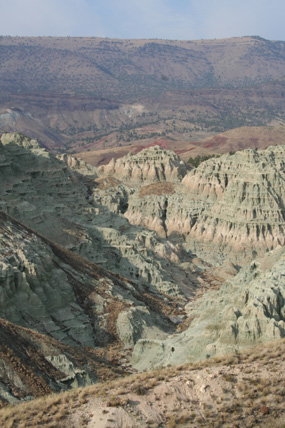 |
| Blue Basin is a favorite hiking area. |
 |
John Day Fossil Beds National Monument protects one of the longest and most continuous records of evolutionary change and biotic relationships in North America.
Here, scientists have unearthed countless fossils of land plants and animals dating back 6 to 54 million years as well as evidence of the dramatic climatic changes that have occurred.
The monument includes over 14,000 acres found in 3 widely separated units, the Sheep Rock Unit, Painted Hills Unit, and Clarno Unit. All 3 units are in the John Day River Basin, a major tributary of the Columbia River and the longest undammed river that flows into the Columbia today.
Deep ravines and eroded, fossil-bearing formations bisect the steep mountainous terrain. The monument lies within the Blue Mountain physiographic province in northeast Oregon. With average rainfall in the 9-16 inch range,due to the rain shadow effects from the Cascades and Ochoco Mountains to the west, it is categorized as a semi-arid climate. Elevations run from 2,000 to 4,500 feet within the John Day Fossil Beds and much of the precipitation for the area comes as snow in the winter.
The river and streams are vital to the survival of many of the wildlife species inhabiting the monument. Over 50 species of birds, 40 species of mammals, 14 species of reptiles, 6 species of amphibians, and 10 species of fish use the park either seasonally or yearlong. Over 240 plants and flowers have adapted to the growing conditions found here.
Two Research Natural Areas are found in the Sheep Rock Unit and protect nearly pristine vegetative communities. Seventy-five acres of agricultural land is irrigated and maintained to preserve the cultural landscape of the Cant Ranch National Historic District.
| 





